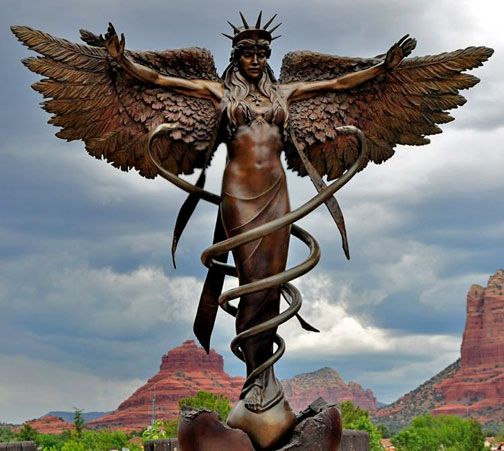Darkness gathers. Demons begin to stir.
—Carl Sagan

Snakes and Flies
I was in Beersheba, in central Negev, witnessing my friend, Damien, making his public vows to become a monk.
Eventually, he’d become a solitary anchorite, or hermit.
Not my idea of a career choice, but then, I’ve always avoided religion either through doubt or fear—the possible existence of angels and demons terrified me so I preferred to live in the mundane world where I at least felt secure.
But when a local man approached the abbot and said he stumbled across an ancient artifact in a cave, my curiosity got the better of me and I agreed to accompany Damien and the abbot to retrieve what could be a priceless archeological find.
We drove south for half an hour until we came to a cluster of tents near where the man claimed he found a statue.
I began to have regrets when the man claimed there was an eerie presence in the cave emanating from the stone statue he said was an idol. He shivered as he described a sense of evil coming from it.
But I was too ashamed to admit my fear so I went with the two men in search of the artifact and after a long search we finally located the cave.
The three of us began searching the interior, and after some time, Damien suddenly called out, “I found the idol.”
When the abbot saw the statue, he hissed in displeasure.
“It’s as I suspected,” he growled, “it’s an effigy of Baal.”
From the expression on his face it may as well have been a statue of Satan.
Baal was ranked as the principal ruler in hell, ruling over the East with 66 legions of demons—but to some, he wasn’t just a high-ranking devil, but Lucifer himself.
I was always interested in archeology and instantly recognized what we had found.
“This idol is several thousand years old,” I told the two men. “It’s an enormous find.”
“It’s evil,” The abbot says through clenched teeth. “I find it loathsome to look at.”
I began excavating the sand from around its base.
“It actually smells sulphurous,” I exclaimed, “it has an odour reminiscent of spent matches.”
The abbot was not surprised.
“The stone has probably been exposed to fire. The Canaanites used to sacrifice their children to the flames to appease Baal.”
The abbot’s words nauseated me—but the find was of immense importance, from an archeological perspective.
“Look!” Damian cried out; he pointed outside the cave, back towards the desert.
The pale blue of the sky in the east had become tarnished like a spreading spot of grease. As we watched, it turned a darker shade of gunmetal blue and began quickly expanding.
“I’ve never seen anything like that,” the abbot whispered.
Dust devils sprang up from the ground, whirling and hissing, ascending like minarets, twisting high into the air.
Within minutes an ominous dark front began moving in and pink flashes of lightning illuminated a cloudy geography.
The first rumblings of thunder shook the mountain and the cave where we stood.
The abbot’s expression grew very stern. “This is not the work of Jinns, but of demons. We need to cover the idol and leave this place.”
I was about to object when a terrific roar split the heavens and a red bolt of lightning forked down, striking within a hundred yards of us.
Damien covered his ears and fell to his knees.
Abba Arsenius looked heavenward and began praying:
“O God, do not leave me. I have done nothing good in your sight, but according to your goodness, let me now make a beginning of good.”
He pushed me aside and began scooping handfuls of dirt over the idol.
I motioned for Damien to help and together the three of us succeeded in covering it—and as we did, the storm outside began to subside.
We left the cave and fled back to the car and headed back to Beersheba.
We didn’t look back.
The Negev is a rocky desert. It’s a land of dry bones, of brown dusty mountains and dry riverbeds that bloom after a rain.
It’s a forbidding place. Sand dunes can reach 30 meters high.
If the land has a demography, it’s a demonology – and no one goes there but Bedouins, or hermits or fools searching for artifacts, such as us.
The scriptures speak of the Azazel, goat-like spirits or Jinns who haunt the desert. To appease these, the Israelites brought sacrifices.
They brought them to the rugged strong rocks of the desert.
They brought them out of fear.
But i t was also here where Isaac built his altar and Jacob saw his ladder with angels ascending and descending.
It was here where Elijah hid in the cave and heard not the dry rasp of demons, but the still, small voice of God.
The Negev is forbidding, yes, but only as a desolate place.
I still have a fear of demons, but I’ll leave the Baal to his wilderness—out of respect for powers greater than I can barely comprehend.
Baal can have this desolate place—this haunt of jackals...
For the time being.
But one day the desert will bloom—water will gush forth and the burning land will become a pool.
No lion, or any ravenous beast will be there.
You see, I know how the story ends.
Until then, I’ll leave the demon to the dry rasping whispers of sand—to the buzzing of flies, over the carcass of a goat.
Yes, it's such a fine hell for him to spend with his companions—the hissing snakes.
They coil and uncoil, slithering out of his mouth.